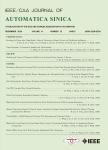版权所有:内蒙古大学图书馆 技术提供:维普资讯• 智图
内蒙古自治区呼和浩特市赛罕区大学西街235号 邮编: 010021

作者机构:IEEE the School of Computer Science and Engineering&Key Laboratory of Machine Intelligence and Advanced ComputingMinistry of EducationSun Yat-sen UniversityGuangzhou 510006China the School of AutomationGuangdong Polytechnic Normal UniversityGuangzhou 510665China the State Key Laboratory of Robotics and SystemsHarbin Institute of Technology(HIT)Harbin 150080China
出 版 物:《IEEE/CAA Journal of Automatica Sinica》 (自动化学报(英文版))
年 卷 期:2022年第9卷第10期
页 面:1778-1791页
核心收录:
学科分类:080202[工学-机械电子工程] 08[工学] 0804[工学-仪器科学与技术] 0835[工学-软件工程] 0802[工学-机械工程] 080201[工学-机械制造及其自动化]
基 金:supported by the National Natural Science Foundation of China(62173352,62103112) the Guangdong Basic and Applied Basic Research Foundation(2021A1515012314) the Open Project of Shenzhen Institute of Artificial Intelligence and Robotics for Society(AC01202005006) the Key-Area Research and Development Program of Guangzhou(202007030004)
主 题:Dual zeroing neural networks(ZNN) finite-time convergence model-free robot control robustness analysis
摘 要:Taking advantage of their inherent dexterity,robotic arms are competent in completing many tasks *** a result of the modeling complexity and kinematic uncertainty of robotic arms,model-free control paradigm has been proposed and investigated ***,robust model-free control of robotic arms in the presence of noise interference remains a problem worth *** this paper,we first propose a new kind of zeroing neural network(ZNN),i.e.,integration-enhanced noise-tolerant ZNN(IENT-ZNN)with integration-enhanced noisetolerant ***,a unified dual IENT-ZNN scheme based on the proposed IENT-ZNN is presented for the kinematic control problem of both rigid-link and continuum robotic arms,which improves the performance of robotic arms with the disturbance of noise,without knowing the structural parameters of the robotic *** finite-time convergence and robustness of the proposed control scheme are proven by theoretical ***,simulation studies and experimental demonstrations verify that the proposed control scheme is feasible in the kinematic control of different robotic arms and can achieve better results in terms of accuracy and robustness.